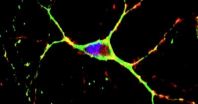"The development of antibiotics has been stalled for several decades and many infectious microbes have become drug-resistant," says the study's senior investigator, Dr. Kyu Y. Rhee, an infectious disease expert who is an associate professor of medicine in the Division of Infectious Diseases and associate professor of microbiology and immunology at Weill Cornell Medical College. "We must restock the antibiotic pipeline and our study findings provide a powerful new approach for doing just that."
The need to develop new antibiotics is perhaps nowhere more pressing than for the treatment of tuberculosis, TB, which is the single leading bacterial cause of death worldwide, and with the emergence of now total drug resistance, an unchecked global public health emergency.
"Current TB treatments are long and complex, lasting a minimum of six months, and often resulting in treatment failures and the paradoxical emergence of multi-drug resistance," says Dr. Rhee, who is also an associate attending physician at NewYork-Presbyterian Hospital/Weill Cornell Medical Center. "We are still using the antibiotics that were first developed for TB about 50 years ago."
Most TB drugs -- as well as antibiotics for other infections -- were developed through a combination of empirical approaches, Dr. Rhee explains. "However, it had been impossible to know what the drug was doing inside the bacteria."
That situation has now changed. Dr. Rhee and his colleagues, who include investigators from the National Institutes of Health, applied modern technologies that stem from use of mass spectrometry to directly visualize what happens when these drugs infiltrate TB cells. They can "watch," at a basic biochemical level, what happens to both the antibiotic agent and infecting bacteria over time after the drug is administered.
Mass spectrometry, simply stated, is a tool that weighs individual molecules as a way to identify them. It was first used in physics, but has expanded to many disciplines to help scientists identify molecules and determine the quantity of each kind in gases, liquids, as well as solids. Advances in mass spectrometry have made it possible for biologists to leverage the tool in the last few years, and, with this study, evaluate the intracellular fates and actions of small drug molecules.
This study is the first to show mass spectrometry can also be adapted to understand the action of antibiotics on living, intact bacterial cells.
In the study, Dr. Rhee's research team exposed TB to para-aminosalicylic acid (PAS), which was developed more than 50 years ago, and is still part of the multi-drug regimen used to treat resistant TB. It is the second oldest TB drug on the market.
The drug was thought to work by inhibiting an enzyme used by bacteria to synthesize folates, an essential class of nutrients that humans acquire by eating, but bacteria must make on their own. "Many thus believed that the drug interfered with folate synthesis in the TB bacterium by functioning as an occlusive plug that blocked this pathway," says Dr. Rhee.
However, researchers actually found, while it is true PAS prevents the utilization of the natural precursors used to synthesize folates, once inside TB, PAS itself also turns toxic. "PAS is an agent that uses the TB cell's machinery to turn it into a poison. Thus, it doesn't simply kill the cell by stopping its food supply, it also morphs into a lethal drug," Dr. Rhee says.
The researchers also tested a different drug, sulfonamide (sulfa), which is an 80-year-old class of antibacterial agents known to defeat many infections, but not TB successfully.
"Scientists thought sulfa didn't penetrate TB cells, but we witnessed, using mass spectrometry, that it did, in fact, enter the bacteria. But that once inside, TB bacteria were able to degrade the drug," Dr. Rhee says. This finding suggests to researchers that it might be possible to modify the sulfa molecule so that it can withstand degradation by TB bacteria.
"Both of these findings were completely unexpected," says Dr. Rhee. "The study findings show us that sometimes there is a profound disconnect between what we think a drug is doing and how it actually works inside cells."
"The power of mass spectrometry is now evident, and we can't wait to use it to test all of the current cocktail of drugs used to treat TB to find ways to improve them," Dr. Rhee says. "Best of all will be the use of this tool to design and test the much-needed next generation of effective anti-TB agents."
INFORMATION:
Researchers who contributed to this research study include Dr. Sumit Chakraborty from Weill Cornell Medical College and Dr. Todd Gruber, Dr. Clifton E. Barry III and Dr. Helen I. Boshoff, from the Tuberculosis Research Section at the National Institute for Allergy and Infectious Diseases, part of the National Institutes of Health.
The researchers are members of the TB Drug Accelerator, a new consortium of four research institutions and seven pharmaceutical companies who are working together to design and test new TB drugs. The program is funded by the Bill & Melinda Gates Foundation.
This work was also supported, in part, by the William Randolph Hearst Foundation, a Burroughs Wellcome Foundation Career Award in the Biomedical Sciences to Dr. Rhee, and the NIH Intramural Research Program of the National Institute of Allergy and Immunology.
Weill Cornell Medical College
Weill Cornell Medical College, Cornell University's medical school located in New York City, is committed to excellence in research, teaching, patient care and the advancement of the art and science of medicine, locally, nationally and globally. Physicians and scientists of Weill Cornell Medical College are engaged in cutting-edge research from bench to bedside, aimed at unlocking mysteries of the human body in health and sickness and toward developing new treatments and prevention strategies. In its commitment to global health and education, Weill Cornell has a strong presence in places such as Qatar, Tanzania, Haiti, Brazil, Austria and Turkey. Through the historic Weill Cornell Medical College in Qatar, the Medical College is the first in the U.S. to offer its M.D. degree overseas. Weill Cornell is the birthplace of many medical advances -- including the development of the Pap test for cervical cancer, the synthesis of penicillin, the first successful embryo-biopsy pregnancy and birth in the U.S., the first clinical trial of gene therapy for Parkinson's disease, and most recently, the world's first successful use of deep brain stimulation to treat a minimally conscious brain-injured patient. Weill Cornell Medical College is affiliated with NewYork-Presbyterian Hospital, where its faculty provides comprehensive patient care at NewYork-Presbyterian Hospital/Weill Cornell Medical Center. The Medical College is also affiliated with the Methodist Hospital in Houston. For more information, visit weill.cornell.edu.
END


